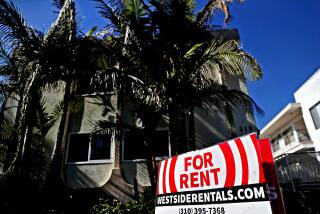Begins April 1 in Santa Monica : Few Satisfied With Rental Repair Plan
The Santa Monica Rent Control Board’s yearlong study of rent increases to cover interior improvements has yielded a program that nobody seems to like.
It is scheduled to begin April 1. Apartment owners spokesman James Baker said he expects “close to zero” participation from landlords because rent increases allowed under the plan are too low. And rent board administrator Howell Tumlin conceded that no one was “overjoyed” about the program.
Tumlin said the board approved the plan, which allows tenants and landlords to negotiate for interior repairs, because it was viewed as a first step toward a full-scale capital improvement program. But Baker charged that board members “caved in” to militant tenants seeking to limit their rents.
“There was some genuine hope that, after all this time, the rent board was sincere about wanting to put something in that would work,” Baker said. “I think there’s a great deal of disillusionment. . . . This is just economic nonsense. Why has the board caved in once again?”
Under the plan, the maximum allowable rent increase is $20 a month or 5% of the rent, whichever is greater. Tenants and landlords can negotiate for interior improvements on items such as furniture, appliances, doors, toilets, showers, light fixtures, windows, dead bolts and security bars.
Baker and 35 other apartment owners participated in more than 13 months of talks on the plan, designed to help stop the deterioration of Santa Monica’s apartment stock.
Landlords originally called for unlimited rent increases if tenants agreed to the terms. The board’s staff suggested a maximum $40 a month increase or 10% of the allowable rent. The Mid-City Neighbors Assn. suggested the $20 increase. And hundreds of tenants called for no increase whatsoever, despite the fact that tenant complaints about apartment maintenance have more than doubled since rent control was enacted six years ago.
Commissioner Leslie Lambert said the board voted 4 to 1 to accept the Mid-City plan because it was encouraged that a community group had come out in favor of any kind of rent hike program. But Lambert said she doubted that the program would have any broad effect, noting that $20 a month wouldn’t do “a heck of a lot” to pay a landlord’s loan for property improvements.
“It’s really more symbolic than anything else,” Lambert said. “I would imagine that the (landlords) feel somewhat betrayed, to tell you the truth. . . . What they probably don’t understand is how difficult it is to sit up here and listen to 500 tenants tell you they don’t want the program. This is really the only compromise that we thought was feasible.
“There has been some theorizing that it will be the smaller buildings that use the program. I really don’t know, but at this point we’re looking at it. . . . It’s a first step, and we’ll be looking at it again in six months. If there’s no participation, we’ll try to redesign it.”
Commissioner Eileen Lipson also characterized the program as experimental and admitted that she considered voting against it. Wayne Bauer, the only board member to oppose the plan, argued that the current rents are fair.
“This seemed like a very bad idea from a conceptual standpoint,” Bauer said. “The landlord community didn’t like it and the tenant community didn’t like it. No one really cared for the idea, so I saw no reason to vote for it.”
Board Chairman David Finkel, who suggested the compromise, also conceded that “nobody was happy” with the idea. But Finkel maintained that the plan is a good experiment at the very least.
“What really interested us was getting beyond this project and getting to the point of addressing structural improvements,” Finkel said. “The whole process of interior improvements was sort of a warm-up vehicle to get us into the process of really addressing the major issue.”
While he was not overly optimistic about the plan, board administrator Tumlin predicted that some landlords would take advantage of the new program because it streamlines the process for obtaining rent hikes.
Lengthy Process
Under the current plan, apartment owners are required to complete a lengthy application and submit to a hearing process that can take as long as four months. The plan allows for a maximum 10% increase a year, but many landlords have complained that the process was too complicated. The board will offer a simple application form under the new process that is designed to take no more than 30 days.
“I think everyone, including Wayne Bauer, would agree that a simplified process is a good objective,” Tumlin said. “And I think everyone would agree . . . that some kind of incentive program is required. . . . The commissioners view it as a very limited program that doesn’t get to the heart of capital improvements. These are not the tough issues.”
But Baker argued that the board has already shown it is unwilling to give landlords reasonable incentives to make improvements. Reading from a study that showed Santa Monica’s rents are 27% lower now in terms of real inflation than before rent control, Baker predicted that the landlords would hold out against paying for improvements for meager rent increases.
“The apartment owners aren’t interested in being lenders,” Baker said. “In most cases (the landlords) will let the deterioration continue. The overwhelming majority of the owners . . . will not put good money after bad.”
More to Read
Sign up for Essential California
The most important California stories and recommendations in your inbox every morning.
You may occasionally receive promotional content from the Los Angeles Times.






